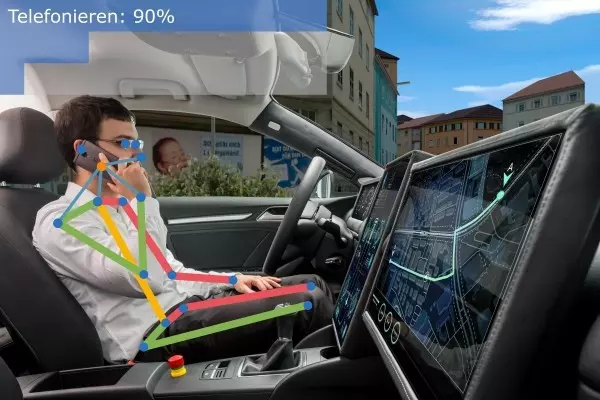Keeping an eye on vehicle occupants
Cameras and radar sensors are now conquering vehicle interiors. In combination with intelligent algorithms, they are designed to provide added safety and comfort.
A driver who nods off for just two seconds or checks emails at a speed of 100 km/h travels more than 50 meters—and does so while flying blind. Studies show that this is an underrated risk; they estimate that around one in ten accidents is caused by distraction or fatigue. That’s why, starting in 2024, the European Commission will require GSR (General Safety Regulation) technical devices for driver monitoring in new registrations. By 2038, this could save more than 25,000 lives and prevent at least 140,000 serious injuries.
In addition, the consumer organization Euro NCAP—a society of European transport ministries, automobile clubs and insurance associations—will offer points for installing interior camera systems starting as early as 2023. In particular, Child Presence Detection (CPD) is a highly rated feature. The U.S. Federal Highway Traffic Safety Administration NHTSA also includes this technology when awarding its coveted stars.
Automobile manufacturers and suppliers have responded to these requirements for some time. After all, future mobility models such as automated or autonomous driving require permanent observation of the vehicle driver, at least, since the situation-based return of the “steering wheel” to the driver is only feasible if the system recognizes that the driver is capable.
Turning the car into a a smartwatch
To that end, Continental is integrating optics minimized to 10 mm and radar sensor technology directly into the display. The combination of both technologies opens up all areas of the interior and thus a wide range of use cases. For example, cabin sensing reliably detects adults, children and animals. Living objects “reveal themselves” by breathing, among other things.
In the future, the technology is expected to detect other health parameters such as pulse, respiration rate or body temperature, so that in the event of a health emergency, for example, the vehicle can be brought to a safe halt by means of a minimum risk maneuver.
AI as a lifesaver
At Bosch, a camera built into the steering wheel detects when drivers’ eyes are at risk of closing, when they are distracted, or when they turn their head toward the front passenger or rear seats. In such cases, the AI sounds an alarm, suggests breaks or even reduces the speed of the vehicle.
Occupant monitoring systems are trained with recordings of real driving situations. To do this, the CARISSMA Institute of Safety in Future Mobility (C-ISAFE) at Ingolstadt Technical University has created a database (100 driving hours, 130 TB) with data from actual traffic scenarios of commuters and long-distance drivers. It contains videos of drivers’ faces (RGB and IR cameras) and road environment (dashboard camera), physiological data (from smartwatch and ECG), and subjective assessments of stress and drowsiness during trips. These data are used to develop algorithms that assess driver fitness, among other things.

Driver pose
The AI from Fraunhofer IOSB detects not only the face, but also the current poses of the vehicle occupants. To do this, the system abstracts the images of the occupants onto a digital skeleton that replicates the physical poses. Together with supplementary object recognition, the skeletal movement then provides information about whether the person is sleeping or distracted, for example, and how long it will take to turn their full attention back to the road.
The hardware consists of classic video cameras, supported by infrared as well as 3D cameras—“TOF cameras” (Time of Flight), which use the time-of-flight method to measure the distance of objects to the sensor.
To meet data protection and security requirements, the data never leaves the vehicle. It is also not stored after real-time evaluation. And since the Fraunhofer researchers do not use personalized models, there is no need to collect personal data. The technology therefore respects privacy from the outset and thus complies with the strict regulations in the EU.
